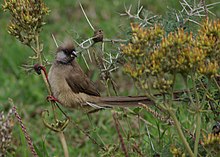| Colius | |
|---|---|

| |
| Speckled mousebird, Colius striatus | |
| Scientific classification | |
| Domain: | Eukaryota |
| Kingdom: | Animalia |
| Phylum: | Chordata |
| Class: | Aves |
| Order: | Coliiformes |
| Family: | Coliidae |
| Genus: | Colius Brisson, 1760 |
| Type species | |
| Loxia colius Linnaeus, 1766
| |
| Species | |
|
Colius colius | |
Colius is a genus of mousebirds in the family Coliidae. The four species are widely distributed in Africa. Two other African mousebirds are placed in the genus Urocolius.
The genus Colius was introduced by the French zoologist Mathurin Jacques Brisson in 1760 with the white-backed mousebird (Colius colius) as the type species.[1][2]
The genus contains the following four species:[3]
| Image | Scientific name | Common Name | Distribution |
|---|---|---|---|
 |
Colius colius | White-backed mousebird | southern Africa from Namibia and southern Botswana eastwards to Central Transvaal and the eastern Cape |
 |
Colius castanotus | Red-backed mousebird | Angola and the Democratic Republic of the Congo |
 |
Colius leucocephalus | White-headed mousebird | southern Somalia and parts of Kenya with its range just extending into southern Ethiopia and northern Tanzania |
 |
Colius striatus | Speckled mousebird | Cameroon east to Eritrea and Ethiopia, south through eastern Africa to southern South Africa |
A fossil species, Colius hendeyi, was described from Early Pliocene remains found at Langebaanweg in South Africa.
Some Miocene taxa from France were previously assigned to Colius. Of these, only the Middle Miocene "Colius" palustris might plausibly belong there,[4] but it is more often separated in Necrornis. In younger lineages like Passeriformes, extant genera (e.g. Menura and Orthonyx) were around by then, though simply because two taxa are of same taxonomic rank, they do not need to be of the same age. All that can be said is that while it cannot be ruled out that the modern genus Colius was around in Miocene Europe, it more likely evolved later, and probably in sub-Saharan Africa.
"Colius" archiaci, "C." consobrinus and "C." paludicola on the other hand are 3 taxa described from fragmentary remains found at Saint-Gérand-le-Puy. Their taxonomic history is convoluted, being initially described as woodpeckers and variously merged and split. Today it is believed that they might all belong to a species in the modern genus Urocolius, or at least 2 into a prehistoric genus Limnatornis.[4]
- ^ Brisson, Mathurin Jacques (1760). Ornithologie, ou, Méthode Contenant la Division des Oiseaux en Ordres, Sections, Genres, Especes & leurs Variétés (in French and Latin). Paris: Jean-Baptiste Bauche. Vol. 1, p. 36, Vol. 3, p. 304.
- ^ Peters, James Lee, ed. (1945). Check-list of Birds of the World. Vol. 5. Cambridge, Massachusetts: Harvard University Press. p. 143.
- ^ Gill, Frank; Donsker, David, eds. (2019). "Mousebirds, trogons, Cuckoo Roller". World Bird List Version 9.1. International Ornithologists' Union. Retrieved 2 April 2019.
- ^ a b Mlíkovský (2002)